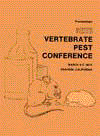Vertebrate Pest Conference: Proceedings

Vertebrate Pest Conference Proceedings: 6th (1974)
Date of this Version
March 1974
Document Type
Article
Abstract
I appreciate the invitation to address this assembly, and hasten to inform you that I come before you as a Director and representative of the Introgene Foundation of Oklahoma City, not as one who has been actively performing the research of which I shall speak, although I have been following it very closely for approximately five years. I am grateful to the Foundation for sending me to this Conference to present this paper. The biological control of animal populations took on a new dimension with the development of radiation-induced sterility in the screw-fly some two decades ago, and since that time it has been the dream of population biologists that a similar technique might be developed for controlling populations of vertebrate pests. A means for this may now be at hand for the Norway rat, as a result of the serendipitous occurrence of a remarkable mutation in the rat colony used by Dr. Allan Stanley and Dr. Laurence Gumbreck at the University of Oklahoma School of Medicine. This colony, consisting of animals derived originally from a cross between King and Holtzman rats, was maintained for the study or reproductive endocrinology and related phenomena. In 1962 a female rat borne in this colony was observed to have an aberrant color pattern, which the investigators perpetuated so that its inheritance might be studied. Without going into the details of the expression of this character in various color patterns of laboratory rats, suffice it to say that in wild-colored animals the gene expresses itself by a white spot or streak on the forehead and a white area of variable extent on the abdomen. In many cases this extends up on the sides as well . In studying the inheritance of this color pattern it was discovered that males exhibiting the character also were sterile . Successful crosses, therefore, could only be accomplished using normal males, and mutant females. Litters from these matings produced normal and mutant females in equal numbers, as well as equal numbers of normal and sterile males. Anyone with a knowledge of genetics will recognize this as the classic distribution of characters in a heterozygous backcross to a homozygous recessive parent. Since in 18 generations of test crosses, p l u s many hundreds of additional matings, the color marker and the sterility factor invariably are transmitted together, the conclusion is inescapable that the two expressions are controlled by a single pleiotropic dominant gene (Gumbreck, et. a l . , 1971).

